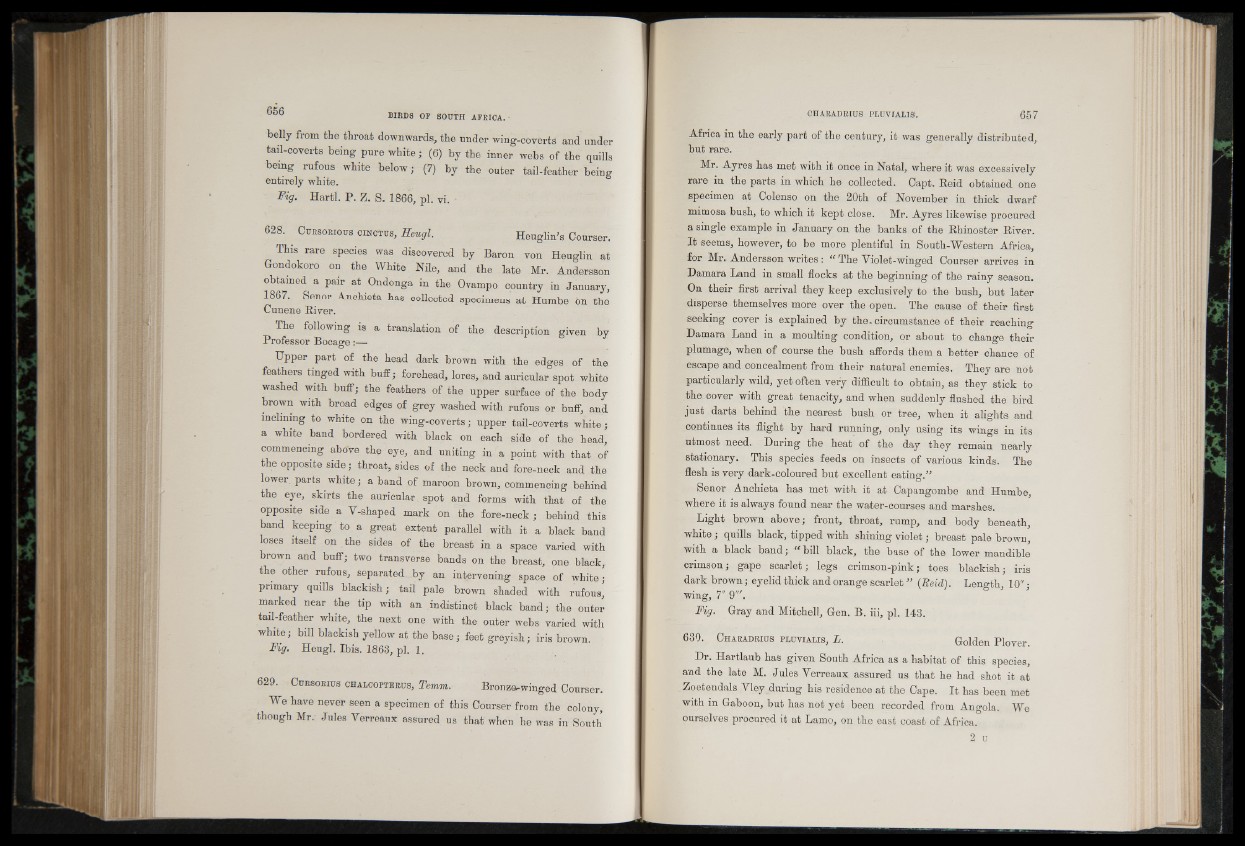
belly from the throat downwards, the under wing-coverts and under
tail-coverts being pure white; (6) by the inner webs of the quills
being rufous white below; (7) by the outer tail-feather being
entirely white.
Fig. Hartl. P. Z. S. 1866, pi. yi.
628. C ursorious cinctus, Eeugl. Heuglin’s Courser.
This rare species was discovered by Baron von Heuglin at
Gondokoro on the White Nile, and the late Mr. AndersSon
obtained a pair at Ondonga in the Ovampo country in January,
1867. Senor Anchieta has collected specimens at Humbe on tho
Cunene River.
The following is a translation of the description given by
Professor Bocage:—
Upper part of the head dark brown with the edges of the
feathers tinged with buff; forehead, lores, and auricular spot white
washed with buff; the feathers of the upper surface of the body
brown with broad edges of grey washed with rufous or buff, and
inclining to white on the wing-coverts; upper tail-coverts white;
a white band bordered with black on each side of the head,
commencing above the eye, and uniting in a point with that of
the opposite side; throat, sides of the neck and fore-neck and the
lower parts white; a band of maroon brown, commencing behind
the eye, skirts the auricular spot and forms with that of the
opposite side a Y-shaped mark on the fore-neck ; behind this
band keeping to a great extent parallel with it a black band
loses itself on the sides of the breast in a space varied with
brown and buff; two transverse bands on the breast, one black,
the other rufous, separated by an intervening space of white;
primary quills blackish; tail pale brown shaded with rufous,
marked near the tip with an indistinct black band; the outer
tail-feather white, the next one with the outer webs varied with
white; bill blackish yellow at the base; feet greyish; iris brown.
Fig. Heugl. Ibis. 1863, pi. 1.
629. C ursorius chalcopterus, Temm. Bronza-winged Courser.
We have never seen a specimen of this Courser from the colony,
though Mr. Jules Yerreaux assured us that when he was in South
Africa in the early part of the century, it was generally distributed,
but rare.
Mr. Ayres has met with it once in Natal, where it was excessively
rare in the parts in which he collected. Capt. Reid obtained one
specimen at Colenso on the 20th of November in thick dwarf
mimosa bush, to which it kept close. Mr. Ayres likewise procured
a single example in January on the banks of the Rhinoster River.
It seems, however, to be more plentiful in South-Western Africa,
for Mr. Andersson writes: “ The Yiolet-winged Courser arrives in
Damara Land in small flocks at the beginning of the rainy season.
On their first arrival they keep exclusively to the bush, but later
disperse themselves more over the open. The cause of their first
seeking cover is explained by the. circumstance of their reaching
Damara Land in a moulting condition, or about to change their
plumage, when of course the bush affords them a better chance of
escape and concealment from their natural enemies. They are not
particularly wild, yet often very difficult to obtain, as they stick to
the cover with great tenacity, and when suddenly flushed the bird
just darts behind the nearest bush or tree, when it alights and
continues its flight by hard running, only using its wings in its
utmost need. During the heat of the day they remain nearly
stationary. This species feeds on insects of various kinds. The
flesh is very dark-coloured but excellent eating.”
Senor Anchieta has met with it at Capangombe and Humbe,
where it is always found near the water-courses and marshes.
Light brown above; front, throat, rump, and body beneath,
white; quills black, tipped with shining violet; breast pale brown,
with a black band; “ bill black, the base of the lower mandible
crimson; gape scarlet; legs crimson-pink; toes blackish; iris
dark brown; eyelid thick and orange scarlet ” (Reid). Length 10" •
wing, 7" 9"'.
Fig. Gray and Mitchell, Gen. B. iii, pi. 143.
630. Oharadrius plu v ia l is , L. Golden Plover.
Dr. Hartlaub has given South Africa as a habitat of this species,
and the late M. Jules Yerreaux assured us that he had shot it at
Zoetendals Yley during his residence at the Cape. It has been met
with in Gaboon, but has not yet been recorded from Angola. We
ourselves procured it at Lamo, on the east coast of Africa.
2 u